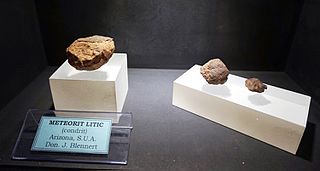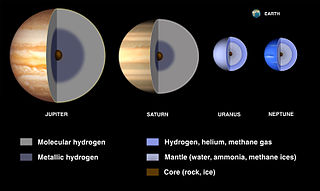Geochemistry is the science that uses the tools and principles of chemistry to explain the mechanisms behind major geological systems such as the Earth's crust and its oceans. The realm of geochemistry extends beyond the Earth, encompassing the entire Solar System, and has made important contributions to the understanding of a number of processes including mantle convection, the formation of planets and the origins of granite and basalt. It is an integrated field of chemistry and geology.

Earth's outer core is a fluid layer about 2,260 km (1,400 mi) thick, composed of mostly iron and nickel that lies above Earth's solid inner core and below its mantle. The outer core begins approximately 2,889 km (1,795 mi) beneath Earth's surface at the core-mantle boundary and ends 5,150 km (3,200 mi) beneath Earth's surface at the inner core boundary.

In meteoritics, a meteorite classification system attempts to group similar meteorites and allows scientists to communicate with a standardized terminology when discussing them. Meteorites are classified according to a variety of characteristics, especially mineralogical, petrological, chemical, and isotopic properties.

A chondrite is a stony (non-metallic) meteorite that has not been modified, by either melting or differentiation of the parent body. They are formed when various types of dust and small grains in the early Solar System accreted to form primitive asteroids. Some such bodies that are captured in the planet's gravity well become the most common type of meteorite by arriving on a trajectory toward the planet's surface. Estimates for their contribution to the total meteorite population vary between 85.7% and 86.2%.

A planetary core consists of the innermost layers of a planet. Cores may be entirely solid or entirely liquid, or a mixture of solid and liquid layers as is the case in the Earth. In the Solar System, core sizes range from about 20% to 85% of a planet's radius (Mercury).

A micrometeorite is a micrometeoroid that has survived entry through the Earth's atmosphere. Usually found on Earth's surface, micrometeorites differ from meteorites in that they are smaller in size, more abundant, and different in composition. The IAU officially defines meteoroids as 30 micrometers to 1 meter; micrometeorites are the small end of the range (~submillimeter). They are a subset of cosmic dust, which also includes the smaller interplanetary dust particles (IDPs).

Meteoric iron, sometimes meteoritic iron, is a native metal and early-universe protoplanetary-disk remnant found in meteorites and made from the elements iron and nickel, mainly in the form of the mineral phases kamacite and taenite. Meteoric iron makes up the bulk of iron meteorites but is also found in other meteorites. Apart from minor amounts of telluric iron, meteoric iron is the only naturally occurring native metal of the element iron on the Earth's surface.
Meteoritics is the science that deals with meteors, meteorites, and meteoroids. It is closely connected to cosmochemistry, mineralogy and geochemistry. A specialist who studies meteoritics is known as a meteoriticist.

Iron meteorites, also called siderites or ferrous meteorites, are a type of meteorite that consist overwhelmingly of an iron–nickel alloy known as meteoric iron that usually consists of two mineral phases: kamacite and taenite. Most iron meteorites originate from cores of planetesimals, with the exception of the IIE iron meteorite group

In geochemistry, the primitive mantle is the chemical composition of the Earth's mantle during the developmental stage between core-mantle differentiation and the formation of early continental crust. The chemical composition of the primitive mantle contains characteristics of both the crust and the mantle.
CI chondrites, also called C1 chondrites or Ivuna-type carbonaceous chondrites, are a group of rare carbonaceous chondrite, a type of stony meteorite. They are named after the Ivuna meteorite, the type specimen. CI chondrites have been recovered in France, Canada, India, and Tanzania. Their overall chemical composition closely resembles the elemental composition of the Sun, more so than any other type of meteorite.
Winonaites are a group of primitive achondrite meteorites. Like all primitive achondrites, winonaites share similarities with chondrites and achondrites. They show signs of metamorphism, partial melting, brecciation and relic chondrules. Their chemical and mineralogical composition lies between H and E chondrites.

IAB meteorites are a group of iron meteorites according to their overall composition and a group of primitive achondrites because of silicate inclusions that show a strong affinity to winonaites and chondrites.
IIG meteorites are a group of iron meteorites. The group currently has six members. They are hexahedrites with large amounts of schreibersite. The meteoric iron is composed of kamacite.

Nonmagmatic meteorite is a deprecated term formerly used in meteoritics to describe iron meteorites that were originally thought to have not formed by igneous processes, to differentiate them from the magmatic meteorites, produced by the crystallization of a metal melt. The concept behind this was developed in the 1970s, but it was quickly realized that igneous processes actually play a vital role in the formation of the so-called "nonmagmatic" meteorites. Today, the terms are still sometimes used, but usage is discouraged because of the ambiguous meanings of the terms magmatic and nonmagmatic. The meteorites that were described to be nonmagmatic are now understood to be the product of partial melting and impact events and are grouped with the primitive achondrites and the achondrites.
This is a glossary of terms used in meteoritics, the science of meteorites.

IIAB meteorites are a group of iron meteorites. Their structural classification ranges from hexahedrites to octahedrites. IIABs have the lowest concentration of nickel of all iron meteorite groups. Most iron meteorites are derived from the metallic planetary cores of their respective parent bodies, but in the case of the IIABs the metallic magma separated to form not only this meteorite group but also the IIG group.
The K/U Ratio is the ratio of a slightly volatile element, potassium (K), to a highly refractory element, uranium (U). It is a useful way to measure the presence of volatile elements on planetary surfaces. The K/U ratio helps explain the evolution of the planetary system and the origin of Earth's moon.
CM chondrites are a group of chondritic meteorites which resemble their type specimen, the Mighei meteorite. The CM is the most commonly recovered group of the 'carbonaceous chondrite' class of meteorites, though all are rarer in collections than ordinary chondrites.
Gas-rich meteorites are meteorites with high levels of primordial gases, such as helium, neon, argon, krypton, xenon and sometimes other elements. Though these gases are present "in virtually all meteorites," the Fayetteville meteorite has ~2,000,000 x10−8 ccSTP/g helium, or ~2% helium by volume equivalent. In comparison, background level is a few ppm.











